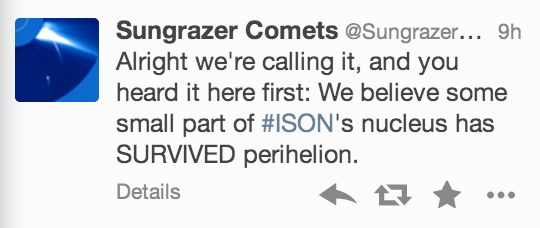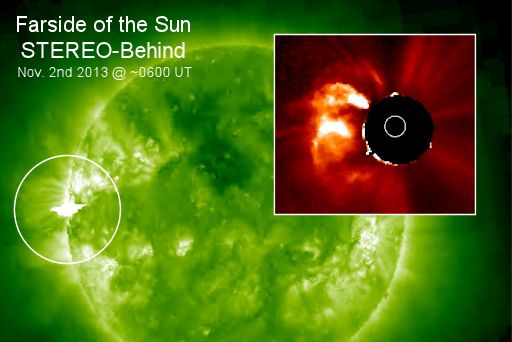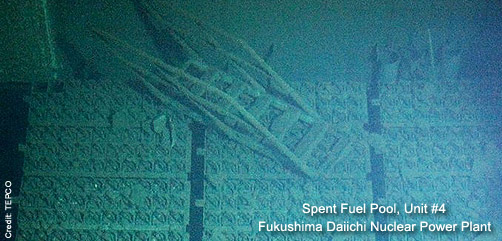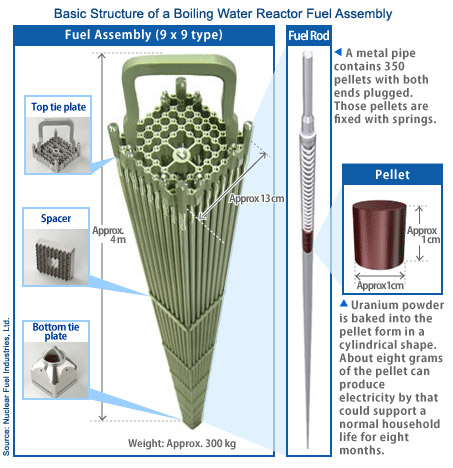Tokyo
Electric Power Company (TEPCO) has announced they will soon begin
attempting removal of more than 1200 spent nuclear fuel assemblies from a
cooling pool more than 100 feet above ground at the severely damaged
Fukushima #4 reactor. As previously reported by AlertsUSA Threat
Journal on multiple occasions, scientists worldwide have warned for well
over two years of the global dangers and implications of this process.
In the case of Fukushima Unit #4, the racks holding the fuel assemblies were damaged and deformed
during the earthquake and explosion in March of 2011. The building is
shattered, structurally unsound and highly vulnerable. In addition,
spent nuclear fuel cannot be simply lifted into the air by a crane. It
must be lifted and transferred at all times in water and heavily
shielded structures.
During the removal process, if the
fuel assemblies touch, are dropped or break open there is potential for
uncontrolled nuclear reactions and explosions to occur.
According to Robert Alvarez,
former Senior Policy Adviser to the Secretary of Energy, Deputy
Assistant Secretary for National Security and one of the nation's
leading experts on spent fuel pools, "There is more than 37 million
curies of long lived radioactivity stored up in the spent fuel just
within this single pool. If another severe earthquake were to strike
causing the pool to drain, or some other event such as an explosion, it
could result in a catastrophic radiological fire releasing nearly 10 times the amount of Cs-137 [into the Earths atmosphere] as was released by the Chernobyl accident.
And that is just one of approximately 200 different types of radioactive isotopes that could potentially be released.
According to Gregory Jaczko, former Chairman of U.S. Nuclear Regulatory Commission, the upcoming attempt to remove Fukushima Unit 4 spent fuel is "unprecedented, the pool has significant structural damage and that the overall effort is very risky."
According to Arnie Gunderson, Sr. Engineer at Fairewinds Energy and a former nuclear industry executive with more than 40 years experience, "TEPCO
has already admitted that the boron shields in the fuel racks
separating the fuel bundles have deteriorated. These shields absorb
neutrons and keep the the fuel cells subcritical."
According to Yale University Professor Emeritus Charles Perrow, a frequent author for the Bulletin of Atomic Scientists, "This has me scared." In the event of an explosion, "Tokyo
would have to be evacuated because of cesium and other poisons that are
there will spread very rapidly. Even if the wind is blowing the other
way it's going to be monumental."
According to Mycle Schneider, an energy consultant and adviser to members of the European Parliament and the Int'l Atomic Energy Agency, "A
massive spent fuel fire would likely dwarf the current dimensions of
the catastrophe and could exceed the radioactivity releases of Chernobyl
dozens of times."
His and other's concerns are not
limited to Japan. An accident in this fuel removal process will have
dramatic public health ramifications for the United States and Canada
many times worse than the original Fukushima explosions and meltdowns.
It must be understood that the U.S.
is directly downwind. In a worse case scenario you will have only a few
days to make any type of preparedness moves to protect yourself and
family as prevailing winds and weather patterns carry airborne
contaminants to the East for rainout / fallout across N. America.
And
here is the kicker: The fuel removal process is expected to take many
months, if not longer. But it has to be done. Leaving the spent fuel in
the damaged pool is not an option.
Readers need to give
serious to consideration to the warnings in this story. As repeatedly
referenced in the lead up to this fuel removal effort, we strongly urge
you to download the 3 free nuclear emergency preparedness guides below
and actually read them. They are written for you by some of this
nation's most skilled and knowledgeable in the area of radiation safety
and preparedness.
AlertsUSA monitors activities at
the Fukushima facility 24/7/365 and will immediately notify service
subscribers of significant developments via text messages to their
mobile devices.
Get the service. Stay Informed.
| 










